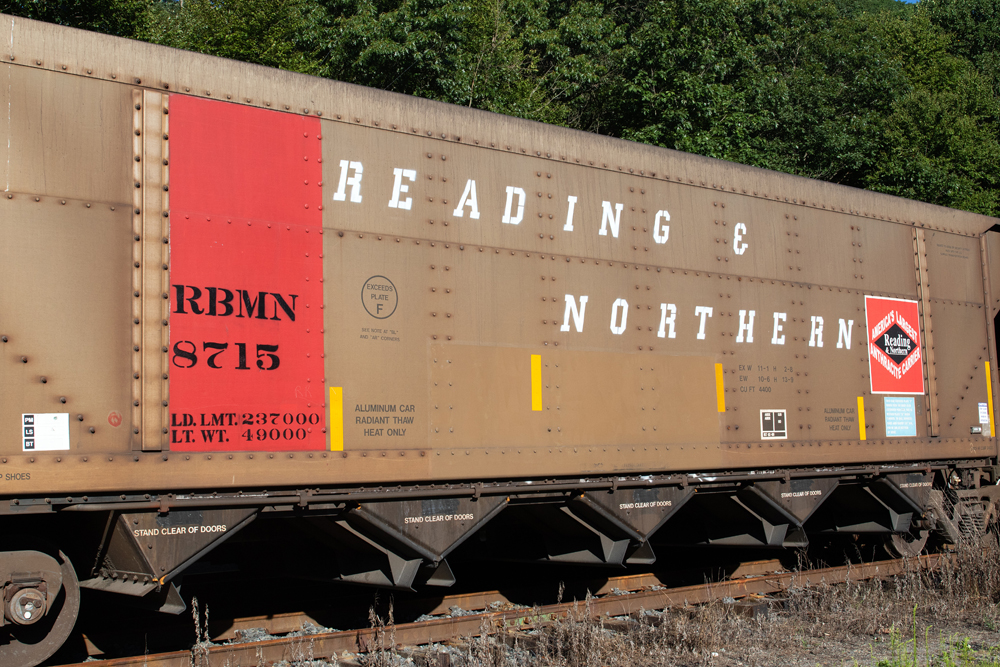
PORT CLINTON, Pa. — The Reading & Northern Railroad announced today it has moved one million tons of coal this year, reaching that long-sought goal for the first time in its 33-year history.
The milestone reinforces the “Road of Anthracite” slogan adopted by owner and CEO Andy Muller since launching the railroad with an initial purchase of lines from Conrail in 1990.
“Watching our company grow has been the accomplishment of my lifetime,” Muller said in a press release. “We now own over 400 miles of track, 1,800 freight cars, more than 65 locomotives, and employ over 350 full- and part-time employees. It’s thanks to those great employees that we have now accomplished that seemingly unattainable goal.”
The railroad services more than 80 customers in nine eastern Pennsylvania counties and handles nearly 40,000 carloads annually, as well as more than 300,000 riders with its passenger department, which offers steam-and diesel-powered excursions.
“Andy pursued this business like a true entrepreneur,” said railroad President Wayne Michel. “He risked millions of dollars in buying hundreds of coal cars and investing in facilities both on and off the railroad, which was unprecedented in the industry. Andy has invested in infrastructure at distant ports not directly served by RBMN as well as customer facilities hundreds of miles away from the railroad.”
Michel also credited a coal marketing team including senior vice president Bill Clark, and vice presidents Jim Cerulli and Mike Sharadin, and said that, “Thanks to the foundation provided by Andy, we are well-positioned for continued growth in the years to come.”














In what universe are nearly all coal fired power plants shutting down by 2030. Nuclear power plants in the US are nearing the end of their life cycle and are to expensive to rebuild and they produce 25 percent of energy needs. That generation capacity has to be made up somewhere and it wouldn’t be with solar or wind. It will be made up with fossil fuel.
China brings on average one coal fired power plant per week, dozens under construction, and hundreds planned. And China burns some of the dirtiest coal. Solar panel to produce electricity for a billion people, you’re dreaming.
1 million tons of coal is nearly 3 million tons of CO2.
That’s nothing to be proud of, but at least the coal industry is dying a rapid death these days, with nearly all plants closing by 2030. I hope they have a business plan that involves hauling zero tons of coal, because it’s coming.
Most coal shipped by R&N probably goes overseas. So, unless China, India and other coal importers adopt our environmental policies (and there’s no indication they are in any hurry to do so), R&N will continue hauling coal for the foreseeable future.
Not all anthracite coal is burnt, it is an excellent median for water filtration.
Will be used for a long time after 2030.
Chinese coal consumption has been basically flat since 2013, and is unlikely to ever increase, given that they are the world’s largest producer of solar panels and are rapidly catching up in wind.
But don’t let facts stand in the way of climate denialism!
U.S. Energy Information Administration | Annual Coal Report 2022
Production
In 2022, U.S. coal production increased 2.9% to 594.2 million short tons (MMst) from 2021, while the number of producing mines increased to 548 mines from 512 mines in 2021. Coal production in basins east of the Mississippi river increased 4.6%, and production increased 1.8% in basins west of the Mississippi river.
The Appalachian region’s coal production in 2022 was 160.5 MMst, an increase of 3.5% from 2021. West Virginia’s production increased 6.3% to 83.4 MMst, Eastern Kentucky’s production increased 19.4% to 12.1 MMst, and Pennsylvania’s production decreased 6.5% to 39.7 MMst.
Coal production in the Interior region was 98.3 MMst, an increase of 5.5% from 2021. Production in Indiana increased 21.1% to 23.6 MMst , production in Illinois increased 2.4% to 37.5 MMst, and production in Western Kentucky increased 0.8% to 16.4 MMst. Production in the rest of the Interior region increased 0.2% to 20.8 MMst, led by a production increase in Mississippi of 5.3% to 3.4 MMst.
Coal production in the Western region in 2022 increased 1.9% to 334.8 MMst. Production in Wyoming, the largest coal-producing state in the region, increased by 2.5% to 244.7 MMst. Other large producing states in the basin include North Dakota, where production increased by 0.8% to 26.7 MMst; Colorado, where production increased by 7.7% to 12.8 MMst; and Montana, where production decreased by 1.2% to 28.2 MMst.
Disposition of coal during 2022 totaled 593.2 MMst, of which 532.3 MMst was marketed as thermal coal and 60.9 MMst was marketed as metallurgical coal. Of the metallurgical coal dispositions, 46.5 MMst was exported, and 14.5 MMst was sold to domestic customers.
Productive capacity
Productive capacity is the maximum amount of coal that can be produced annually as reported by mining companies. In 2022, the collective productive capacity of U.S. coal mines increased 0.1% to 872 MMst. Major producing states that reported an increase in productive capacity include Virginia (7.9% to 13.3 MMst) and West Virginia (7.1% to 111.2 MMst). States with a decrease in reported productive capacity include Texas (-6.7% to 17.2 MMst) and Utah (-9.6% to 18.0 MMst).
The overall capacity utilization across all mines increased to 68.0% in 2022 from 66.1% in 2021. Capacity utilization is measured as the ratio of annual production to the annual productive capacity of mines.
Exports
Exports increased by 1.0 MMst in 2022 to 86.0 MMst. Europe was the top destination of U.S. exports, accounting for 33.6 MMst. Steam coal exports accounted for 45.9% (39.5 MMst) of the total, and metallurgical coal accounted for 54.1% (46.5 MMst).
Coal business on the R&N looks very good!!!!
Met coal is going to be used for a long time both domestically and export.
There is a move or green steel (requires LOTS of NG) but not going to replace current steel production for many decades.
Good Job.
Job well done.